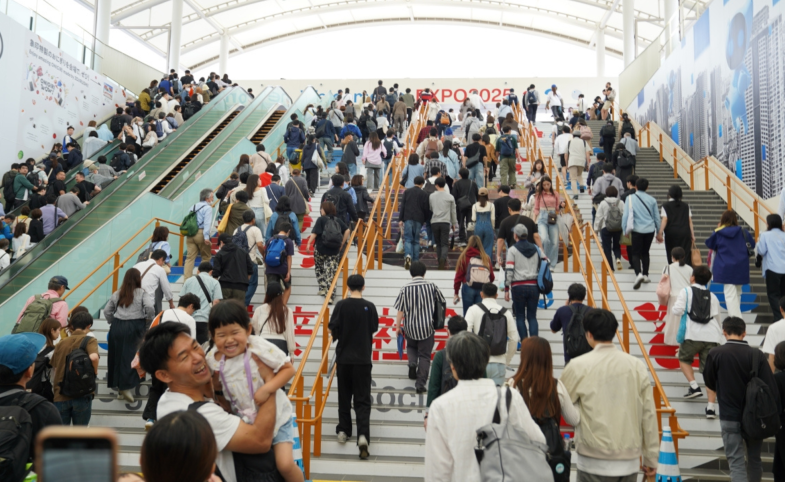The CPD Blog is intended to stimulate dialog among scholars and practitioners from around the world in the public diplomacy sphere. The opinions represented here are the authors' own and do not necessarily reflect CPD's views. For blogger guidelines, click here.

5 Ideas to Strengthen the World Expo
Visiting the World Expo in Osaka this May, I was struck by both the event’s enduring promise and a sense of unrealized possibility. The World Expo remains one of the few global platforms where countries come together to share culture and their visions for the future. Its ability to convene the world is especially remarkable in an age of rising distrust and discord. The Osaka Expo, like its recent predecessors, showcased ideas about culture, technology, and sustainability, and generated moments of international engagement that underscored the value of collective imagination and participation.
Yet even as these moments affirmed the Expo’s continuing relevance and significance, they also revealed its limits. Having attended three previous Expos, I arrived in Osaka with a degree of familiarity. I expected the usual mix: national pavilions vying for attention, long queues, striking architecture, and a few delightful surprises. Those still exist, and they matter. But as I moved from one pavilion to another, the experience felt more like navigating a sprawling department store of displays than embarking on a journey of collective discovery. The all-encompassing nature of the event that once defined the Expo now feels somewhat out of step with today’s world of information abundance and saturation. While it satisfies the human desire for conviviality, spectacle, and the joy of browsing, visitors can easily feel overwhelmed and disoriented, without a clear sense of how the parts connect or what larger story is being told.
This points to the fundamental tension at the heart of the Expo model today. As it convenes the world, the Expo does so primarily as a collection of national showcases rather than as an integrated experience. Each Expo is built around a theme – Osaka’s was “Designing Future Society for Our Lives” – yet the nominal theme rarely coheres into a distinct storyline that guides visitors’ journeys across the site. For today’s globally mobile, digitally connected visitors, the appeal of this patchwork format may no longer spark interest or sustain engagement. It is not surprising that while the Expo is arguably the largest public diplomacy event of the year, it proceeds without the world truly paying attention.
The World Expo is many things – forums, events, and pavilions. Still, nations and their pavilions remain at center stage, with public engagement as the event’s core mission. How, then, might the World Expo continue to reinvent itself to stay relevant and meaningful in the twenty-first century? Several considerations may help to rethink the narrative and the medium of the Expo.
"The event must continue to rediscover what makes it distinctive; not just its scale or spectacle, but its capacity to tell a compelling global story, forge connections with the public, and invite them to visit and to belong and dream together."
First, the Expo could be conceived as a six-month narrative arc. Instead of a static exhibition, organizers could treat it as a story that unfolds over time – for instance, by connecting exhibits and programs on the ground to ongoing global conversations. This would help visitors situate their experiences within a broader meaning structure rather than leave with a scatter of impressions. It would also open avenues for engagement on and beyond the fairgrounds.
At the pavilion level, countries should embrace more experimentation in their approach. The Expo’s great legacy lies in its role as a testing ground for the future. As some countries have begun to demonstrate, pavilions could be designed less as showcases and more as laboratories of innovation, inviting visitors to participate, co-create, and imaging possibilities that inspire bottom-up energy and practices. This would elevate the exploratory spirit that once made the Expo a site of wonder and forward thinking.
While national representation remains central, new forms of cross-country, cross-sector, or thematic collaboration could complement and diversify visitor experiences. Shared programs, joint exhibits, and stronger co-presence among pavilions would better reflect the interconnected challenges of our time and encourage dialogue across the local settings of national pavilions. Such efforts could deepen awareness of forging common bonds among strangers and different cultures, a goal that has always been part and parcel of the Expo’s mission.
Digital technology could also play a vital role in enhancing visitors’ experience. An intelligent digital companion could guide visitors through the vast landscape of hundreds of attractions and activities, linking exhibits conceptually and spatially, tailoring recommendations, facilitating connections, and improving comfort and efficiency. Such an AI-enabled navigation tool could make the Expo a genuinely hybrid experience, bridging physical presence and digital engagement in ways that enrich understanding and participation.
Finally, build a more robust legacy strategy. From a public diplomacy standpoint, what happens after the Expo matters as much as what happens during it. The event could serve as a catalyst for continuing connection and collaboration beyond the closing ceremony. Legacy should not be confined to physical infrastructure but conceived as an unfolding narrative and a set of sustained relationships.
As the Osaka Expo draws to a close, I am left with admiration for the immense effort involved in mounting this grand event but also with a lingering sense of untapped potential. The World Expo still matters, as it allows people and countries, for a moment, to look at something beyond themselves and be reminded of the very essence of relational life. The event must continue to rediscover what makes it distinctive; not just its scale or spectacle, but its capacity to tell a compelling global story, forge connections with the public, and invite them to visit and to belong and dream together.
Looking ahead, the 2027 Specialized Expo in Belgrade, focused on sports and music, offers a promising opportunity to infuse more creativity and human connection into the Expo movement. And with Riyadh hosting the next World Expo in 2030, there is a chance to carry forward the spirit of renewal, ensuring that the Expo continues to evolve and expand as a unique global communal moment.
(Featured photo by Yao Li)
Visit CPD's Online Library
Explore CPD's vast online database featuring the latest books, articles, speeches and information on international organizations dedicated to public diplomacy.
POPULAR ARTICLES
-
November 3
-
November 5
-
November 13
-
October 16
-
October 16
Join the Conversation
Interested in contributing to the CPD Blog? We welcome your posts. Read our guidelines and find out how you can submit blogs and photo essays >.









